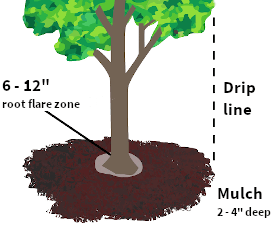2–3 minute read
method
 modified from Spraytech Mulching to improve tree and plant health
modified from Spraytech Mulching to improve tree and plant health
- Use the ‘donut’ method to prevent bark decay and discourage rodents from chewing bark: leave the root flare uncovered. Keep mulch at least 6–12 inches away from tree trunks and at least 3–6 inches away from the base of smaller plants.
- When mulching individual trees in lawns, create a circle of mulch about 2 feet in diameter for each inch of trunk diameter. Ideally, mulch out to a tree’s drip line or beyond, at least an 8 foot diameter around the tree. Remember that in a forest environment, a tree’s entire root system (which extends well beyond the drip line) would be mulched.
Amount
The recommended mulch depth depends on its texture and density. If a mulch layer is too thick, roots will grow in the mulch instead of in the soil.
Wood & bark mulches
These often contain fine particles and should not be more than 2–3″ deep after settling. Excessive depth of fine-textured mulches around shallow-rooted plants can suffocate the roots, causing chlorosis and poor growth.
Coarse-textured mulches
Mulches that allow good air movement, such as pine needles and pine bark nuggets, can be as deep as 4″.
New plantings
Avoid more than 1″ of mulch on a newly installed plants. Too much can cause drought stress to new plants because the mulch intercepts water meant for the roots.
Winter mulch
Mulch can be applied more thickly in winter to prevent the roots of tender plants from freezing. Winter mulch should be a loose material such as straw, hay or pine boughs that will help to insulate plants without compacting under the weight of snow and ice. To stimulate plant growth in the spring, rake away the mulch to allow the ground temperature to increase. When plant growth has begun, the mulch should be returned to a depth of about 3″.
How much to purchase
Mulch is often sold in bags, by the yard or by the truckload. The area that can be covered to a depth of 3″ is listed below:
| Unit | Coverage, sq ft |
|---|---|
| bag (2 cu ft) | 8 |
| bale of pine straw | 18–20 |
| cubic yard | 108 |
| mini-pickup load (1.5 yards) | 162 |
| full-sized pickup load (2.5 yards) | 270 |
Timing
Mulched soil warms up more slowly in the spring and cools down more slowly in the fall. Because it acts as an insulator, the best time to apply mulch depends on whether the goal is weed suppression or insulation.
For weed suppression
Mulch used to conserve moisture and suppress weeds is best applied after the soil has warmed up in the spring. Cool, wet soils can slow seed germination, increase the decay of seeds and seedlings, and increase disease pressure in perennial beds.
Weed Control & Organic Mulches …
For insulation
Mulch used to moderate winter temperatures should be applied after the ground has frozen but before the coldest temperatures arrive. Applying mulch before the ground has frozen delays plants from entering dormancy, increasing susceptibility to injury from cold snaps. In addition, early mulch can attract rodents looking for a warm over-wintering site.
Frequency
Organic mulch breaks down over time and can be worked into the soil as an amendment. Alternatively, new mulch can be spread over existing mulch, keeping overall depth at the optimum for the mulch type used. Pine straw usually needs to be applied yearly.
